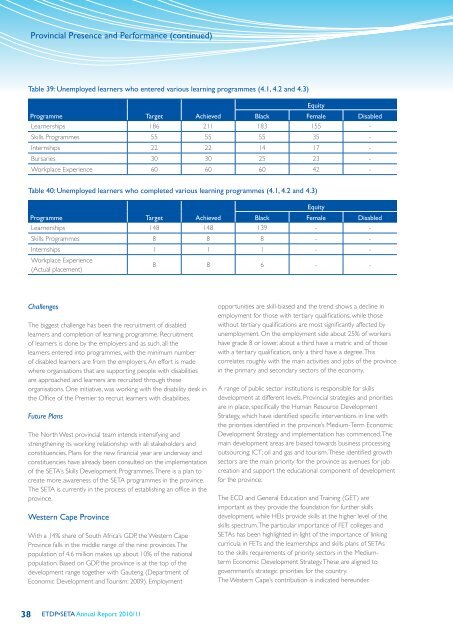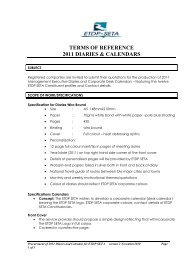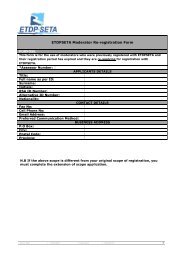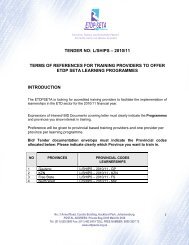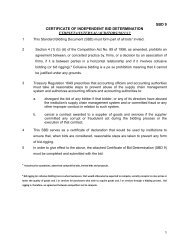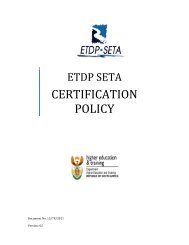Here - ETDP Seta
Here - ETDP Seta
Here - ETDP Seta
Create successful ePaper yourself
Turn your PDF publications into a flip-book with our unique Google optimized e-Paper software.
Provincial Presence and Performance (continued)<br />
Table 39: Unemployed learners who entered various learning programmes (4.1, 4.2 and 4.3)<br />
Equity<br />
Programme Target Achieved Black Female Disabled<br />
Learnerships 186 211 183 155 -<br />
Skills Programmes 55 55 55 35 -<br />
Internships 22 22 14 17 -<br />
Bursaries 30 30 25 23 -<br />
Workplace Experience 60 60 60 42 -<br />
Table 40: Unemployed learners who completed various learning programmes (4.1, 4.2 and 4.3)<br />
Programme Target Achieved Black Female Disabled<br />
Learnerships 148 148 139 - -<br />
Equity<br />
Skills Programmes 8 8 8 - -<br />
Internships 1 1 1 - -<br />
Workplace Experience<br />
(Actual placement)<br />
8 8 6 - -<br />
Challenges<br />
The biggest challenge has been the recruitment of disabled<br />
learners and completion of learning programme. Recruitment<br />
of learners is done by the employers and as such, all the<br />
learners entered into programmes, with the minimum number<br />
of disabled learners are from the employers. An effort is made<br />
where organisations that are supporting people with disabilities<br />
are approached and learners are recruited through these<br />
organisations. One initiative, was working with the disability desk in<br />
the Office of the Premier to recruit learners with disabilities.<br />
Future Plans<br />
The North West provincial team intends intensifying and<br />
strengthening its working relationship with all stakeholders and<br />
constituencies. Plans for the new financial year are underway and<br />
constituencies have already been consulted on the implementation<br />
of the SETA’s Skills Development Programmes. There is a plan to<br />
create more awareness of the SETA programmes in the province.<br />
The SETA is currently in the process of establishing an office in the<br />
province.<br />
Western Cape Province<br />
With a 14% share of South Africa’s GDP, the Western Cape<br />
Province falls in the middle range of the nine provinces. The<br />
population of 4.6 million makes up about 10% of the national<br />
population. Based on GDP, the province is at the top of the<br />
development range together with Gauteng (Department of<br />
Economic Development and Tourism: 2009). Employment<br />
opportunities are skill-biased and the trend shows a decline in<br />
employment for those with tertiary qualifications, while those<br />
without tertiary qualifications are most significantly affected by<br />
unemployment. On the employment side about 25% of workers<br />
have grade 8 or lower, about a third have a matric and of those<br />
with a tertiary qualification, only a third have a degree. This<br />
correlates roughly with the main activities and jobs of the province<br />
in the primary and secondary sectors of the economy.<br />
A range of public sector institutions is responsible for skills<br />
development at different levels. Provincial strategies and priorities<br />
are in place, specifically the Human Resource Development<br />
Strategy, which have identified specific interventions in line with<br />
the priorities identified in the province’s Medium-Term Economic<br />
Development Strategy and implementation has commenced. The<br />
main development areas are biased towards business processing<br />
outsourcing; ICT; oil and gas and tourism. These identified growth<br />
sectors are the main priority for the province as avenues for job<br />
creation and support the educational component of development<br />
for the province.<br />
The ECD and General Education and Training (GET) are<br />
important as they provide the foundation for further skills<br />
development, while HEIs provide skills at the higher level of the<br />
skills spectrum. The particular importance of FET colleges and<br />
SETAs has been highlighted in light of the importance of linking<br />
curricula in FETs and the learnerships and skills plans of SETAs<br />
to the skills requirements of priority sectors in the Mediumterm<br />
Economic Development Strategy. These are aligned to<br />
government’s strategic priorities for the country.<br />
The Western Cape’s contribution is indicated hereunder.<br />
38 <strong>ETDP</strong>•SETA Annual Report 2010/11


